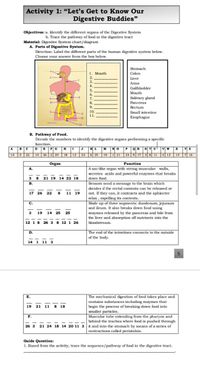
Human Anatomy & Physiology (11th Edition)
11th Edition
ISBN: 9780134580999
Author: Elaine N. Marieb, Katja N. Hoehn
Publisher: PEARSON
expand_more
expand_more
format_list_bulleted
Concept explainers
Question
thumb_up100%
ANSWER ALL

Transcribed Image Text:Activity 1: “Let's Get to Know Our
Digestive Buddies"
Objectives: a. klentify the different organs of the Digestive System
b. Trace the pathway of food in the digestive tract
Material: Digestive System chart/diagram
A. Parts of Digestive System.
Direction: Label the different parts of the human digestive system below.
Choose your answer from the box below,
Stomach
1. Mouth
Colon
2.
Liver
3.
Anus
4.
Gallblädder
5.
Mouth
6.
7.
Salivary gland
8.
Pancreas
9.
Rectum
10.
11.
Small intestine
Esophagus
-10
B. Pathway of Food.
Decode the numbers to identify the digestive organs performing a specific
function.
A BC DE FG H I J KL
M NO POR STU
6 25
Y Z
14 |5| 22
26 2 20 18
19
24 9 17 3 8
11 4 13 15 7 16
10
12
23
1 21
Organ
Function
A sac-like organ with strong muscular walls,
secretes acids and powerful enzymes that breaks
down food.
А.
3
21 19 14 22 18
Sensors send a message to the brain which
decides if the rectal contents can be released or
В.
17 26 22
not. If they can, it contracts and the sphincter
relax , expelling its contents.
Made up of three segments: duodenum, jejunum
and ileum. It also breaks down food using
enzymes released by the pancreas and bile from
the liver and absorption off nutrients into the
8
11 19
с.
-
3
19 14 25
25
-- --
12 1 8 26 3 8 12 1 26
bloodstream.
| The end of the intestines connects to the outside
of the body.
D.
14 1 11 3
5
Е.
The mechanical digestion of food takes place and
contains substances including enzymes that
begin the process of breaking down food into
smaller particles.
Muscular tube extending from the pharynx and
behind the trachea where food is pushed through
19 21 11 8 18
F.
26 3 21 24 18 14 20 11 3 it and into the stomach by means of a series of
contractions called peristalsis.
Guide Question:
1. Based from the activity, trace the sequence/pathway of food in the digestive tract.
Expert Solution
This question has been solved!
Explore an expertly crafted, step-by-step solution for a thorough understanding of key concepts.
This is a popular solution
Trending nowThis is a popular solution!
Step by stepSolved in 2 steps

Knowledge Booster
Learn more about
Need a deep-dive on the concept behind this application? Look no further. Learn more about this topic, biology and related others by exploring similar questions and additional content below.Similar questions
arrow_back_ios
SEE MORE QUESTIONS
arrow_forward_ios
Recommended textbooks for you
 Human Anatomy & Physiology (11th Edition)BiologyISBN:9780134580999Author:Elaine N. Marieb, Katja N. HoehnPublisher:PEARSON
Human Anatomy & Physiology (11th Edition)BiologyISBN:9780134580999Author:Elaine N. Marieb, Katja N. HoehnPublisher:PEARSON Biology 2eBiologyISBN:9781947172517Author:Matthew Douglas, Jung Choi, Mary Ann ClarkPublisher:OpenStax
Biology 2eBiologyISBN:9781947172517Author:Matthew Douglas, Jung Choi, Mary Ann ClarkPublisher:OpenStax Anatomy & PhysiologyBiologyISBN:9781259398629Author:McKinley, Michael P., O'loughlin, Valerie Dean, Bidle, Theresa StouterPublisher:Mcgraw Hill Education,
Anatomy & PhysiologyBiologyISBN:9781259398629Author:McKinley, Michael P., O'loughlin, Valerie Dean, Bidle, Theresa StouterPublisher:Mcgraw Hill Education, Molecular Biology of the Cell (Sixth Edition)BiologyISBN:9780815344322Author:Bruce Alberts, Alexander D. Johnson, Julian Lewis, David Morgan, Martin Raff, Keith Roberts, Peter WalterPublisher:W. W. Norton & Company
Molecular Biology of the Cell (Sixth Edition)BiologyISBN:9780815344322Author:Bruce Alberts, Alexander D. Johnson, Julian Lewis, David Morgan, Martin Raff, Keith Roberts, Peter WalterPublisher:W. W. Norton & Company Laboratory Manual For Human Anatomy & PhysiologyBiologyISBN:9781260159363Author:Martin, Terry R., Prentice-craver, CynthiaPublisher:McGraw-Hill Publishing Co.
Laboratory Manual For Human Anatomy & PhysiologyBiologyISBN:9781260159363Author:Martin, Terry R., Prentice-craver, CynthiaPublisher:McGraw-Hill Publishing Co. Inquiry Into Life (16th Edition)BiologyISBN:9781260231700Author:Sylvia S. Mader, Michael WindelspechtPublisher:McGraw Hill Education
Inquiry Into Life (16th Edition)BiologyISBN:9781260231700Author:Sylvia S. Mader, Michael WindelspechtPublisher:McGraw Hill Education

Human Anatomy & Physiology (11th Edition)
Biology
ISBN:9780134580999
Author:Elaine N. Marieb, Katja N. Hoehn
Publisher:PEARSON

Biology 2e
Biology
ISBN:9781947172517
Author:Matthew Douglas, Jung Choi, Mary Ann Clark
Publisher:OpenStax

Anatomy & Physiology
Biology
ISBN:9781259398629
Author:McKinley, Michael P., O'loughlin, Valerie Dean, Bidle, Theresa Stouter
Publisher:Mcgraw Hill Education,

Molecular Biology of the Cell (Sixth Edition)
Biology
ISBN:9780815344322
Author:Bruce Alberts, Alexander D. Johnson, Julian Lewis, David Morgan, Martin Raff, Keith Roberts, Peter Walter
Publisher:W. W. Norton & Company

Laboratory Manual For Human Anatomy & Physiology
Biology
ISBN:9781260159363
Author:Martin, Terry R., Prentice-craver, Cynthia
Publisher:McGraw-Hill Publishing Co.

Inquiry Into Life (16th Edition)
Biology
ISBN:9781260231700
Author:Sylvia S. Mader, Michael Windelspecht
Publisher:McGraw Hill Education